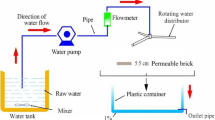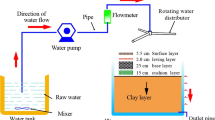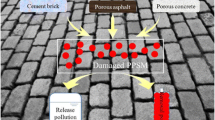Abstract
To investigate the potential pollution risk of permeable brick paving systems in areas with high groundwater levels, a system was constructed by using ceramic permeable bricks as the surface and a Chinese character “well”-shaped frame as the base on the top of a 1.0 m clay layer. The concentrations of total suspended solids (TSS), total phosphorus (TP), ammonia nitrogen (NH4+-N), total nitrogen (TN), chemical oxygen demand (COD), and heavy metals (Zn, Cu, and Pb) at different underground depths were measured, the potential pollution of the groundwater was assessed, and the effectiveness of the fillers inside the frame for improving the quality of the groundwater was discussed. The results showed that NH4+-N and COD concentrations detected at the depth of 0.6 m were higher than that of the national standard for groundwater (GBT14848-2017), these two pollutants had the potential pollution risk. The pollution risk by heavy metals was comparatively low because most of the heavy metals were likely retained in the surface soil by adsorption, complexation, and precipitation, while the pollution risk by TSS and TP was negligible due to the good purification ability in the clay layer. The results suggest that the removal rates of TSS, TP, TN, COD, and heavy metals can be improved by appropriate fillers’ adjustment, such as iron filings, coal slag, or volcanic rocks. This research offers a new perspective on the potential risk of pollution and the governance of groundwater.











Similar content being viewed by others

References
Ahiablame, L. M., Engel, B. A., & Chaubey, I. (2012). Effectiveness of low impact development practices: literature review and suggestions for future research. Water, Air, and Soil Pollution, 223, 4253–4273.
Aryal, R. K., Murakami, M., Furumai, H., Nakajima, F., & Jinadasa, H. K. P. K. (2006). Prolonged deposition of heavy metals in infiltration facilities and its possible threat to groundwater contamination. Water Science and Technology, 4, 205–212.
Banerjee, U. S., Guo, Z. H., Zhou, K. G., & Chai, L. Y. (2017). Distribution and plant availability of Cd, Pb, Cu and As in different particle size soil fractions. Journal of the Indian Chemical Society, 94, 1029–1035.
Bhatnagar, A., & Sillanpaa, M. (2011). A review of emerging adsorbents or nitrate removal from water. Chemical Engineering Journal, 168, 493–504.
Brown, R. A., & Borst, M. (2014). Nutrient infiltrate concentrations from three permeable pavement types. Journal of Environmental Management, 164, 74–85.
Cates, E. L., Westphal, M. J., Cox, J. H., Calabria, J., & Patch, S. C. (2009). Field evaluation of a proprietary storm-water treatment system: removal efficiency and relationships to peak flow, season, and dry time. Journal of Environmental Engineering, 135, 511–517.
Cheng, H. F., Xu, W. P., Liu, J. L., Wang, H. J., He, Y. Q., & Chen, G. (2007). Pretreatment of wastewater from triazine manufacturing by coagulation, electrolysis, and internal microelectrolysis. Journal of Hazardous Materials, 146, 385–392.
Chittoori, B., & Puppala, A. J. (2011). Quantitative estimation of clay mineralogy in fine-grained soils. J Geotech Geoenviron, 137, 997–1008.
Chu, L., & Fwa, T. F. (2019). Evaluation of surface infiltration performance of permeable pavements. Journal of Environmental Management, 238, 136–143.
Collins, K. A., Hunt, W. F., & Hathaway, J. M. (2008). Hydrologic comparison of four types of permeable pavement and standard asphalt in Eastern North Carolina. Journal of Hydrologic Engineering, 13, 1146–1157.
Davis, A. P., & McCuen, R. (2005). Stormwater management for smart growth, 368 pp. New York: Springer.
Davis, A. P., Mohammad, S., Himanshu, S., & Minami, C. (2001). Laboratory study of biological retention for urban stormwater management. Water Environment Research, 73, 5–14.
Drake, J., Bradford, A., & Van, S. T. (2014). Winter effluent quality from partial-infiltration permeable pavement systems. Journal of Environmental Management, 140, 04014036.
Dreelin, E. A., Fowler, L., & Carroll, C. R. (2006). A test of porous pavement effectiveness on clay soils during natural storm events. Water Research, 40, 799–805.
Eck, B. J., Winston, R. J., Hunt, W. F., & Barrett, M. E. (2015). Water quality of drainage from permeable friction course. J Environ Eng, 138, 174–181.
Ferguson, R. B., Eisenbauer, D. E., Bockstadter, T. L., Krull, D. H., & Buttermore, G. (1990). Water and nitrogen management in Central Platte Valley of Nebraska. Journal of Irrigation and Drainage Engineering, 116, 557–565.
Foppen, J. W. A. (2002). Impact of high strength wastewater infiltration on groundwater quality and drinking water supply the case of Sana’a, Yemen. Journal of Hydrology, 263, 198–216.
German ER (1989). Quantity and quality of stormwater runoff recharged to the floridan aquifer system through two drainage wells in the Orlando, Florida, area. U.S. Geological Survey water-supply paper (USA).
Huang, C. P., Wang, H. W., & Chiu, P. C. (1998). Nitrate reduction by metallic iron. Water Research, 32, 2257–2264.
Ingvertsen, S. T., Cederkvist, K., Jensen, M. B., & Magid, J. (2012). Assessment of existing roadside swales with engineered filter soil: II. Treatment efficiency and in situ mobilization in soil columns. Journal of Environmental Quality, 41, 970–1981.
Jensen, J. L., Schjonning, P., Watts, C. W., Christensen, B. T., & Munkholm, L. J. (2017). Soil texture analysis revisited: removal of organic matter matters more than ever. PLoS One, 12, e0178039.
Jiang, W., Sha, A. M., Xiao, J. J., Li, Y. L., & Huang, Y. (2015). Experimental study on filtration effect and mechanism of pavement runoff in permeable asphalt pavement. Construction and Building Materials, 100, 102–110.
Jin, J. R., Li, T., & Shi, Z. B. (2017). Performance of applying scale permeable pavements for control of runoff pollution in an area with high groundwater level. Environmental Sciences, 38, 2379–2384.
Kamali, M., Delkash, M., & Tajrishy, M. (2017). Evaluation of permeable pavement responses to urban surface runoff. Journal of Environmental Management, 187, 43–53.
Khan, U., Valeo, C., Chu, A., & van, D. B. (2012). Bioretention cell efficacy in cold climates: part 1: hydrologic performance. Canadian Journal of Civil Engineering, 39, 1210–1221.
Koupai, J. A., Nejad, S. S., Mostafazadeh-Fard, S., & Behfarnia, K. (2016). Reduction of urban storm-runoff pollution using porous concrete containing iron slag adsorbent. J Environ Eng, 142, 04015072.
Lapworth, D. J., Baran, N., Stuart, M., & Ward, R. S. (2012). Emerging organic contaminants in groundwater: a review of sources, fate and occurrence. Environmental Pollution, 163, 287–303.
Lauer, D. A. (1988). Vertical distribution in soil of unincorporated surface-applied phosphorus under sprinkler irrigation. Soil Science Society of America Journal, 52, 1685–1692.
Li, H., Li, Z., Zhang, X., Li, Z., Liu, D., Li, T., & Zhang, Z. (2017). The effect of different surface materials on runoff quality in permeable pavement systems. Environ Sci Pollut, 24, 21103–21110.
Lin, Z. Z., Chen, H. M., & Yang, H. (2020). Risk of contamination of infiltrated water and underground soil by heavy metals within a ceramic permeable brick paving system. Environemental Science and Pollution Research. https://doi.org/10.1007/s11356-020-08745-w.
Liu, J., Yan, H. X., Zhang, K., Schmidt, A. R., & Tao, T. (2019). Laboratory analysis on the surface runoff pollution reduction performance of permeable pavements. Sci Total Environ, 691, 1–8.
Luk, G. K. (2013). Removal of total phosphorus from domestic wastewater with clay-zeolite medium. Advances in Materials Research, 647, 753–757.
Mcdowell, R. W., & Sharpley, A. N. (2003). The effects of soil carbon on phosphorus and sediment loss from soil trays by overland flow. Journal of Environmental Quality, 321, 207–214.
Ministry of Housing and Urban-Rural Development of the People’s Republic of China. (2012). Technical specification for pavement of water permeable brick (CJJ/T 188–2012). Beijing: China Building Industry Press (in Chinese).
Muhammetoglu, H., Muhammetoglu, A., & Soyupak, S. (2002). Vulnerability of groundwater to pollution from agricultural diffuse sources: a case study. Water Science and Technology, 45, 1–7.
Newman, A. P., Puehmeier, T., Shuttleworth, A., & Pratt, C. J. (2014). Performance of an enhanced pervious pavement system loaded with large volumes of hydrocarbons. Water Science and Technology, 70, 835–842.
Nie, F. H., Li, T., Yao, H. F., Feng, M., & Zhang, G. K. (2008). Characteristics of suspended solids and particle-bound heavy metals in a first flush of highway runoff. Journal of Zhejiang University. Science. A, 11, 1567–1575 (in Chinese).
Nikonov, V., Goryainova, V., & Lukina, N. (2001). Ni and Cu migration and accumulation in forest ecosystems on the Kola Peninsula. Chemosphere., 42, 93–100.
Niu, Z. G., Lv, Z. W., Zhang, Y., & Cui, Z. Z. (2016). Stormwater infiltration and surface runoff pollution reduction performance of permeable pavement layers. Environmental Science and Pollution Research, 23, 2576–2587.
Nolan, J., & Weber, K. A. (2015). Natural uranium contamination in major US aquifers linked to nitrate. Environmental Science & Technology, 2, 215–220.
Pitt, R., Clark, S. M., Parmer, K., & Field, R. (1995). Groundwater contamination from stormwater Infiltration (pp. 127–132). Reston: American Society of Civil Engineers.
Pitt, R., Clark, S., & Field, R. (1999). Groundwater contamination potential from stormwater infiltration practices. Urban Water., 1, 217–236.
Reddy, K. R., Xie, T., & Dastgheibi, S. (2014). Adsorption of mixtures of nutrients and heavy metals in simulated urban stormwater by different filter materials. Journal of Environmental Science and Health, Part A, 49, 524–539.
Revitt, D. M., Lundy, L., Coulon, F., & Fairley, M. (2014). The sources, impact and management of car park runoff pollution: a review. Journal of Environmental Management, 146, 552–567.
Risto, U., Eila, T., Tommi, K., & Lilja, T. (2001). Particulate phosphorus and sediment in surface runoff and drain flow from clayey soils. Journal of Environmental Quality, 30, 589–595.
Rodriguez-Rubio, P., Morillo, E., Madrid, L., Undabeytia, T., & Maqueda, C. (2010). Retention of copper by a calcareous soil and its textural fractions: influence of amendment with two agroindustrial residues. European Journal of Soil Science, 54, 401–409.
Roseen, R. M., Ballestero, T. P., Houle, J. J., Avellaneda, P., Briggs, J., Fowler, G., & Wildey, R. (2009). Seasonal performance variations for storm-water management systems in cold climate conditions. Journal of Environmental Engineering, 135, 128–137.
Roseen, R. M., Ballestero, T. P., Houle, J. J., Avellaneda, P., Briggs, J. F., & Houle, K. M. (2012). Water quality and hydrologic performance of a porous asphalt pavement as a storm-water treatment strategy in a cold climate. Journal of Environmental Engineering, 138, 128–137.
Samuel, M. S., Sheriff Shah, S. K., Subramaniyan, V., Qureshi, T., Bhattacharya, J., & Pradeep Singh, N. D. (2018a). Preparation of graphene oxide/chitosan/ferrite nanocomposite for chromium (VI) removal from aqueous solution. Int J Biol Macromol, 119, 540–547.
Samuel, M. S., Subramaniyan, V., Bhattacharya, J., Chidambaram, R., Qureshi, T., & Pradeep Singh, N. D. (2018b). Ultrasonic-assisted synthesis of graphene oxide – fungal hyphae: an efficient and reclaimable adsorbent for chromium (VI) removal from aqueous solution. Ultrason Sonochem, 48, 412–417.
Samuel, M. S., Sk, S. S., Bhattacharya, J., Subramaniam, K., & Pradeep Singh, N. D. (2018c). Adsorption of Pb (II) from aqueous solution using a magnetic chitosan/graphene oxide composite and its toxicity studies. International Journal of Biological Macromolecules, 115, 1142–1150.
Samuel, M. S., Subramaniyan, V., Bhattacharya, J., Parthibanb, C., Chand, S., & Pradeep Singh, N. D. (2018d). A GO-CS@MOF [Zn (BDC)(DMF)] material for the adsorption of chromium (VI) ions from aqueous solution. Compos Part B-Eng., 152, 116–125.
Samuel, M. S., Bhattacharya, J., Raj, S., Santhanamb, N., Singh, H., & Pradeep Singh, N. D. (2019). Efficient removal of chromium (VI) fromaqueous solution using chitosan grafted graphene oxide (CS-GO) nanocomposite. International Journal of Biological Macromolecules, 121, 285–292.
Samuel, M. S., Selvarajanb, E., Subramaniamc, K., Mathimanid, T., Seethappane, S., & Pugazhendhif, A. (2020). Synthesized β-cyclodextrin modified graphene oxide (β-CD-GO) composite for adsorption of cadmium and their toxicity profile in cervical cancer (HeLa) cell lines. Process Biochemistry, 93, 28–35.
Sannudo-Fontaneda, L. A., Charlesworth, S. M., Castro-Fresno, D., Andres-Valeri, V. C. A., & Rodriguez-Hernandez, J. (2014). Water quality and quantity assessment of pervious pavements performance in experimental car park areas. Water Science and Technology, 69, 1526–1533.
Schipper, L. A., Barkle, G. F., Hadfield, J. C., Vojvodic-Vukovic, M., & Burgess, C. P. (2004). Hydraulic constraints on the performance of a groundwater denitrification wall for nitrate removal from shallow groundwater. Journal of Contaminant Hydrology, 69, 263–279.
Scholz, M. (2013). Water quality improvement performance of geotextiles within permeable pavement systems: a critical review. Water., 5, 462–479.
Soon, Y. K. (1994). Changes in forms of soil zinc after 23 years of cropping following cle. Canadian Journal of Soil Science, 74, 179–184.
Statham, T. M., Mumford, K. A., Rayner, J. L., & Geoffrey, W. S. (2015). Removal of copper and zinc from ground water by granular zero-valent iron: a dynamic freeze–thaw permeable reactive barrier laboratory experiment. Cold Regions Science and Technology, 110, 120–128.
Wang, Z. H., Cao, Y. Q., Wright, A. L., Shi, X. L., & Jiang, X. J. (2019). Different ammonia oxidizers are responsible for nitrification in two neutral paddy soils. Soil and Tillage Research, 195, 104433.
Zhang, J., Hao, Z., Zhang, Z., Yang, Y. P., & Xu, X. H. (2010). Kinetics of nitrate reductive denitrification by nanoscale zero-valent iron. Process Safety and Environmental Protechion., 88, 439–445.
Zhang, Z., Li, Z., Zhang, X. R., Liu, D. Q., Li, Z. R., & Li, H. Y. (2018). Systematically investigated the influences of permeable pavement materials on the water quality of runoff: batch and column experiments. Water, Air, and Soil Pollution, 229, 155.
Zuo, X. J., Fu, D. F., Li, H., & Singh, R. P. (2011). Distribution characteristics of pollutants and their mutual influence in highway runoff. Clean: Soil, Air, Water, 39, 956–963.
Funding
This study was supported by the Science and Technology Project of Jiangsu provincial Construction System (No. 2018ZD203), the National Natural Science Foundation of China (No. 51608272), and the Student’s Innovative Projects of Nanjing Forestry University (2018NFUSPITP769) for financial support.
Author information
Authors and Affiliations
Corresponding author
Additional information
Publisher’s Note
Springer Nature remains neutral with regard to jurisdictional claims in published maps and institutional affiliations.
Rights and permissions
About this article
Cite this article
Lin, ZZ., Chen, HM. & Yang, H. The Potential Pollution Risk of Groundwater by a Ceramic Permeable Brick Paving System. Water Air Soil Pollut 231, 356 (2020). https://doi.org/10.1007/s11270-020-04740-6
Received:
Accepted:
Published:
DOI: https://doi.org/10.1007/s11270-020-04740-6



